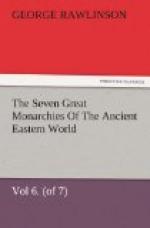The residuum of the truth, or at any rate the important conviction of the ancient writers, which remains after their stories are sifted, is the Scythic character of the Parthian people. On this point, Strabo, Justin, and Arrian are agreed. The manners of the Parthians had, they tell us, much that was Scythic in them. Their language was half Scythic, half Median. They armed themselves in the Scythic fashion. They were, in fact, Scyths in descent, in habits, in character.
But what are we to understand by this? May we assume at once that they were a Turanian people, in race, habits, and language akin to the various tribes of Turkomans who are at present dominant over the entire region between the Oxus and the Parthian mountain-tract, and within that tract have many settlements? May we assume that they stood in an attitude of natural hostility to the Arian nations by which they were surrounded, and that their revolt was the assertion of independence by a down-trodden people after centuries of subjection to the yoke of a stranger? Did Turan, in their persons, rise against Iean after perhaps a thousand years of oppression, and renew the struggle for predominance in regions where the war had been waged before, and where it still continues to be waged at the present day?
Such conclusions cannot safely be drawn from the mere fact that the Scythic character of the Parthians is asserted in the strongest terms by the ancient writers. The term “Scythic” is not, strictly speaking, ethnical. It designates a life rather a descent, habits rather than blood. It is applied by the Greeks and Romans to Indo-European and Turanian races indifferently, provided that they are nomads, dwelling in tents or carts, living on the produce of their flocks and herds, uncivilized, and, perhaps it may be added, accustomed to pass their lives on horseback. We cannot, therefore, assume that a nation is Turanian simply because it is pronounced “Scythic.” Still, as in fact the bulk of those races which have remained content with the nomadic condition, and which from the earliest times to the present day have led the life above described in the broad steppes of Europe and Asia, appear to have been of the Turian type, a presumption is raised in favor of a people being Turanian by decided and concordant statements that it is Scythic. The presumption may of course be removed by evidence to the contrary; but, until such evidence is produced it has weight, and constitutes an argument, the force of which is considerable.
In the present instance the presumption raised is met by no argument of any great weight; while on the other hand it receives important confirmation from several different quarters. It is said, indeed, that as all, or almost all, the other nations of these parts were confessedly Arians (e.g. the Bactrians, the Sogdians, the Chorasmians, the Margians, the Arians of Herat, the Sagartians, the Sarangians, and the Hyrcanians), it would be strange if the Parthians belonged




